At the National Museum in Zürich is a display of Swiss cultural icons. The obvious are included: Swiss cheese, Swiss chocolate, and Swiss watches. Also cowbells, alphorns, and a model of the Matterhorn.
Surprisingly, there are no Swiss army knives. Heidi, however, was not forgotten.
The novel Heidi is about a young girl and her grandfather living in the Alps. Published in 1881 by Johanna Spyri, it is one of the best-selling books ever written.
And then there is the story of Swiss folk-hero William Tell who, like Robin Hood, may never have existed.
In the early 1300s, the Habsburg empire (out of Austria) was seeking to dominate Tell’s region of Switzerland. To demonstrate his power, the local Habsburg overlord hung his hat on top of a pole in the village of Altdorf and demanded every Swiss citizen bow before it.
Tell refused and was arrested.
The overlord had heard of Tell’s skill with a crossbow and so devised a cruel punishment. Tell and his young son would be executed for disobedience unless Tell could shoot an apple off of the top of his son’s head.
Tell took careful aim and split the apple. The overlord asked why Tell had removed two crossbow bolts from his quiver instead of one. Tell replied that if he had killed his son with the first, he would have killed the overlord with the second. This story, fact or fiction, inspired rebellion.
Not a joiner
Switzerland is the country’s stage name.
Its real name is the Confederation of Helvetia, abbreviated on its license tags (CH), its internet domain (.ch), and in reference to its currency (CHF).
Helvetia was selected as the name in 1798 by the new republic’s founding fathers. As the Latin name for the Celtic tribes that once inhabited the region, Helvetia has no connection to the country’s German, French, Italian, and Romansch populations.
The name is neutral.
Switzerland guards its neutrality, along with its independent way of life, stubbornly. Uninvolved directly in either WWI and WWII, the Swiss adamantly avoid alliances that require military, political, or economic commitments (except for the Swiss Guards posted at the Vatican).
Switzerland is not a member of NATO. Only in 2002 did it join the UN. Although surrounded by members of the European Union (EU), Switzerland does not belong.
Switzerland’s reputation for evenhandedness has made it the headquarters of headquarters, including the World Health Organization, the UN High Commission for Refugees, the UN Human Rights Council, the World Trade Organization, and hundreds of others. Switzerland is the birthplace of the Red Cross and the Geneva Conventions.
Twice the size of New Jersey, Switzerland has no coastline. The country consists of twenty-six cantons (like our states). Four national languages are officially recognized and spoken. Its identity as a national community is tied to the Alps.
I began my tour of Switzerland in Zürich, the wealthiest city in Europe with the best quality of life in the world. Being neutral has been very good for Switzerland.
Dadaism and isolationism
Zürich Airport is modern, airy, and shiny. The train ride to the Hauptbahnhof in the city center took only a few minutes. It’s one of the busiest train stations in the world.
Strolling down fashionable Bahnhofstrasse, I set out to explore both sides of the River Limmat.
Sleek trams glided silently by every couple of minutes. I noticed the Swiss never jaywalk and always cross with the light, even when there is no oncoming traffic. As a courtesy, I started doing the same.
On the river, swans uncoiled their necks and scavenged for food in the shallows. A boat club enjoyed Saturday morning eggs and kegs, dressed in their colors. People were swimming.
The Frauenbadi is a women-only facility with a deck on the river. It is used for sunbathing, occasionally in the nude.
Zürich is the largest city in Switzerland with a population of nearly two million. The earliest settlement dates to 4000 BCE. The Romans were here, as seemingly they were everywhere.
I visited Saint Peter’s Church, built on the site of a Roman temple to Jupiter. The steeple, displaying the largest clock face in Europe, was originally used to watch for fires.
At Fraumünster I stepped inside to view the five large stained-glass windows designed by Marc Chagall. The church took a chance when they requested his involvement. (He was eighty years old.)
To their surprise, he accepted. Chagall applied his trademark style to the windows, using bright colors and primitive symbols.
I crossed the river over one of the many footbridges to visit the Niederdorf district. Niederdorf, like most European old towns, is a maze of narrow hilly cobblestone streets, lined with trendy shops and cafés.
In Niederdorf is Grossmünster, a twin-spired church, supposedly commissioned by Emperor Charlemagne. His gold-crowned statue sits on the side of the south tower overlooking the city. Grossmünster is the birthplace of the Swiss-German Reformation, notable for separating church and state, and purging opulence and ritual from the interior of the church.
In the Old Town is Cabaret Voltaire, the birthplace of dadaism, an art movement that rose in protest of World War I. In 1916, a collection of artists, writers and other free-thinkers staged performances in the cabaret, skewering the status quo and shocking the world. Switzerland, given its neutrality, was a logical petri dish for such new ideas.
At a Saturday morning farmers’ market I bought a picnic lunch—local Gruyère cheese, an apple, and a roll. I ate at Lindenhof, an overlook of the river and the Old Town. It was once the site of a Roman castle.
A tour group enjoyed wine and cheese and listened to musicians in traditional clothing play long wooden alphorns.
Keeping secrets
Given its small size, challenging terrain and landlocked position, how did Switzerland manage to achieve such stable prosperity? Much of its financial success can be attributed to its stance on neutrality.
Switzerland’s historic position has kept it out of costly wars, saving it trillions, and positioned it to transact business with every side in a conflict.
The country avoided the cost of rebuilding its infrastructure after World War II, when the rest of Europe was in shambles.
Switzerland is not a member of the EU, as voted by its citizens. To date, the value of the Swiss franc has been more stable than the euro.
Its stability has attracted the wealth of the world to its banks. An estimated one-third of all funds held outside their country of origin are kept in Switzerland’s banks.
Historically, Swiss banks have protected their confidentialities with account holders, just as doctors do with patients.
The banks have famously served crime bosses, terrorists, dictators, and tax-evaders, both corporate and individual. Its deposits include wealth stolen from Jews by the Nazis during World War II, an issue it is just now admitting and addressing.
Pressure from the United States and the EU is slowly opening Switzerland’s vault of secrets. And as might be expected, shady deposits are leaving for more secretive pastures.
Einstein and the child eater
I moved on to Bern, the capital of Switzerland. Bern has a population of over six hundred thousand and is ranked among the world’s top ten cities for, you guessed it, best quality of life.
The layout of Bern’s city center has remained essentially unchanged since it was built between the 1100s and the 1400s. It has been designated by UNESCO as a Cultural World Heritage Site.
As I left the train station, a Dixieland band was tearing it up on the sidewalk. It may have had something to do with a wedding party, as the band and the bride boarded a city bus and pulled away, playing all the while.
The Old Town is built on a peninsula surrounded by the River Aare. I sauntered to the end of the peninsula to visit the Bärengraben (bear park). Since the 1500s, Bern has exhibited bears in the city center. (Bern’s coat-of-arms includes a bear.) Currently three bears ramble around the park and draw crowds. When I visited, two of them sumo-wrestled playfully in the water.
I took the TI’s walking tour with guide Ursula. She showed us wall foundations from the 1300s under the train station. Then Ursula worked her way down the peninsula, sharing information in both English and German. We visited:
• Church of the Holy Spirit, dated to 1228
• Prison Tower, once the second city gate into Bern
• Federal Palace, built in the 1800s and housing the national parliament
• Zytglogge (time bell), an elaborate medieval clock tower with moving figures
• Münster, a cathedral from the 1400s
• Einsteinhaus at Kramgasse 49, where German-born Albert Einstein lived from 1903–1905, the time when his most revolutionary thinking transpired
The most striking attractions are the eleven public fountains from the 1500s, featuring colorful, almost cartoon-like statues. The figures include Sampson, Moses, a bagpiper, a hunter, and so on.
The most bizarre is the statue of an ogre in the process of swallowing a baby. It is called the Child-Eater Fountain. One of several explanations is that it was intended to frighten disobedient children. It frightened me.
Next day, I went to the Kunstmuseum to see the Henri de Toulouse-Latrec exhibit, featuring some of the artist’s work next to related photographs. He didn’t take the photos, but commissioned some of them as reference for his art. The exhibit covered his favorite topics, the theater, society, the Moulin Rouge, brothels, and the circus.
Got a haircut from a female barber who spoke only German. Sign language. She and the manager had a long whispered conversation about how much to charge. I think it was due to my extreme shagginess.
Bern is noted for its shopping. Its long straight medieval streets (four miles’ worth) are arcaded. Shops are under the arches as well as through the cellar doors. The offerings are unique. No chain or designer stores. Violins, antiquarian books, puppets, buttons, men’s hats, fancy fabrics, antiques, and collectibles.
One store sells expensive, well-made gothic-style clothing. Not costumes, but Edwardian waistcoats, leather boots, and silver-handled canes, some with occult designs. Still trying to figure out who shops there—other than vampires.
A fondue of values
The Swiss have an intriguing set of values, which Americans might consider a mix of progressive and conservative.
Conservative
Switzerland believes fiercely in local governance and cantons’ (states’) rights, probably because the cantons developed as political entities long before the confederation was formed. Policy is voted on directly by the citizens through frequent canton-level referendums. (It’s called direct democracy.) As a result, decision-making at the national level is slow and change is rare. Balancing the cantons’ tradition of self-rule with the need for an empowered central government is debated endlessly.
All men are required to serve in the military, although purely for defensive purposes.
Women did not achieve the right to vote throughout Switzerland until 1990! (This change was delayed by the more conservative cantons.)
Switzerland has strict immigration and naturalization policies, even though foreigners make up nearly a fourth of its workforce.
Progressive
Switzerland offers universal health care to its citizens. By law, Swiss workers receive at least four weeks of vacation each year.
The Swiss view drug abuse as a disease, not a crime, and have decriminalized marijuana. (I saw receptacles for the safe disposal of syringes in public restrooms.)
Switzerland’s military does not serve outside the country except in peacekeeping roles.
The Swiss are unified in taking care of their natural environment, gradually converting their energy generation from nuclear to water, wind, and sun. They are avid recyclers. There’s barely a scrap of litter in the whole country.
Swiss culture encourages punctuality and precision, even perfection.
Inside the walls
The little walled town of Murten in rural Fribourg is self-enclosed and protective of its lifestyle, proud of its history, and stubborn in its ways—a small-scale version of Switzerland. The village is tiny. It takes only ten minutes to walk every street. But it is quiet and relaxed and just the sort of place to finish my tour.
While the canton of Fribourg is mostly French-speaking, Murten is mostly German. It sits on the south shore of Lake Morat in the heart of a large agricultural area, famous for its wines. The city was founded in the 1100s and was won and lost by various empires half a dozen times.
The village is protected by thick stone walls, surrounded by a moat, and punctuated with twelve towers. A long section of the ramparts is walkable and the views are expansive.
In 1476 Charles the Bold, Duke of Burgundy, laid siege to Murten. The town was saved by the neighboring Bernese. Some ten thousand Burgundians were massacred or drowned in the lake.
The story is recounted proudly all around the town. It was an early victory for the newly developing Swiss Confederacy.
In 1861 an elephant escaped from an American circus, killed its keeper, and terrified the town before it was shot with a cannon. The cannon ball and elephant’s skull are displayed locally.
On my last night in Switzerland in this quiet little town, I decided to go to a movie. The theater was located in a medieval-aged stone building, yet it was quite modern inside. Only about a dozen movie-goers. I watched Youth, a recent movie that contemplates life and death, in English with German and Italian subtitles. Most of it is set at a spa in the Alps, near where I toured.
The Swiss are so respectful and disciplined. They stayed quietly in their seats until the very last credit rolled.






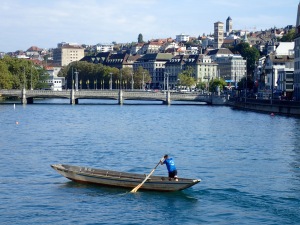

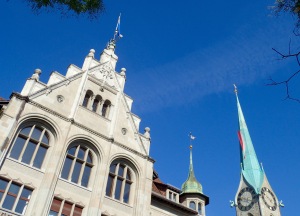

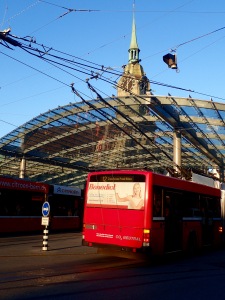
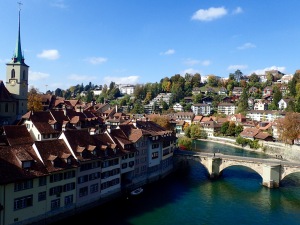




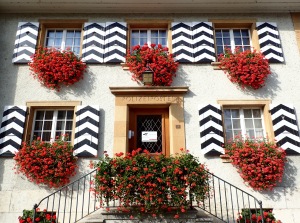




Beautiful!
Lovely pictures and interesting prose!